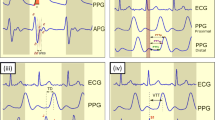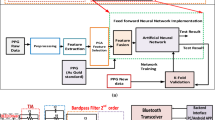Abstract
This paper presents a system which estimates blood glucose level (BGL) by non-invasive method using Photoplethysmography (PPG). Previous studies have shown better estimation of blood glucose level using an optical sensor. An optical sensor based data acquisition system is built and the PPG signal of the subjects is recorded. The main contribution of this paper is exploring various features of a PPG signal using Single Pulse Analysis technique for effective estimation of BGL values. A PPG data of 611 individuals is recorded over duration of 3 minutes each. BGL value estimation is performed using two types of feature sets, (i) Time and frequency domain features and (ii) Single Pulse Analysis (SPA). Neural network is trained using above mentioned proposed feature sets and BGL value estimation is performed. First we validate our methodology using the same features used by Monte Moreno in his earlier work. The experimentation is performed on our own dataset. We obtained comparable results of BGL value estimation as compared with Monte Moreno, with maximum R2 = 0.81. Further, BGL estimation using (i) Time and frequency domain features and (ii) Single Pulse Analysis (SPA) is performed and the resulting coefficient of determination (i.e., R2) obtained for reference vs. prediction are 0.84 and 0.91, respectively. Clarke Error Grid analysis for BGL estimation is clinically accepted, so we performed similar analysis. Using Time and frequency domain feature set, the distributions of data samples is obtained as 80.6% in class A and 17.4% in class B. 1% samples in zone C and Zone D. For Single Pulse Analysis technique (SPA) the distribution of data samples are 83% in class A and 17% in class B. The proposed features in SPA have shown significant improvement in R2 and Clarke Error grid analysis. SPA technique with the proposed feature set is a good choice for the implementation of system for measurement of non-invasive glucometer.















Similar content being viewed by others
References
Monte-Moreno E 2011 Non-invasive estimate of blood glucose and blood pressure from a photoplethysmograph by means of machine learning techniques. Artificial Intelligence in Medicine 53(2): 127–138
Losoya-Leal A, Camacho-León S, Dieck-Assad G and Martínez-Chapa S 2012 State of the art and new perspectives in non-invasive glucose sensors. Revista Mexicana De Ingeniería Biomédica 33(1): 41–52
March W 1974 Noninvasive automatic glucose sensor system US3958560A
So C, Choi K, Wong T and Chung J 2012 Recent advances in noninvasive glucose monitoring. Medical Devices (Auckland, NZ), 5, p.45
Ciudin A, Hernández C and Simó R 2012 Non-invasive methods of glucose measurement: current status and future perspectives. Current Diabetes Reviews 8(1): 48–54
Habbu S, Ghongade R, Aher M 2013 Noninvasive techniques for Blood Glucose Measurement In: Proceedings of International Conference on Electrical, Electronics and Computer Engineering (ICEECS)CHE-016
Fortino G and Giampà V 2010 PPG-based methods for non-invasive and continuous blood pressure measurement: an overview and development issues in body sensor networks. In: Proceedings of IEEE International Workshop on Medical Measurements and Applications pp.10–13
Poon Y and Zhang T 2006 Cuff-less and noninvasive measurements of arterial blood pressure by pulse transit time. In: Proceedings of 27th annual conference of IEEE engineering in medicine and biology pp. 5877–5880
Spigulis J 2005 Optical noninvasive monitoring of skin blood pulsations. Applied Optics 44(10): 1850–1857
Allen J 2007 Photoplethysmography and its application in clinical physiological measurement. Physiological Measurement 28(3): p.R1
Anderson R and Parrish A 1981 The optics of human skin. Journal of investigative Dermatology 77(1): 13–19
Ramasahayam S, Haindavi K and Chowdhury S 2015 Noninvasive estimation of Blood glucose concentration using near infrared optodes Springer, Smart Sensors Meas. Instrum. 12, pp. 67–82
Habbu S 2017 Noninvasive technique for blood glucose measurement using optical methods and soft computing, unpublished project report, BCUD, SPPU Pune
Accu-chek aviva. Last accessed May 2, 2011. URL https://www.accuchek.com/us/glucose-meters/aviva.html
Ronald S 2011 Notes in IEEE Signal Processing Magazine, Issue 4 vol. 28 pp. 111–117 https://doi.org/10.1109/msp.2011.941097
Rabiner L, Juang B and Rutledge J 1993 Fundamentals of speech recognition Englewood Cliffs: PTR Prentice Hall Vol. 14
Dunn R, Quatieri T and Kaiser J 1993 Detection of Transient signalsusing the energy operator. In: Proceedings of the IEEE International Conferenceon Acoustics,Speech, and Signal processing (ICASSP93). p.145–8
Ducher M, Cerutti C, Gustin P, Abou-Amara S, Thivolet C, Laville M, Paultre Z and Fauvel P 1999 Noninvasive exploration of cardiac autonomic neuropathy. Four reliable methods for diabetes? Diabetes Care 22(3): 388–393
Renevey P and Drygajlo A 2001 Entropy based voice activity detection in very noisy conditions. In: Proceedings of Seventh European Conference on Speech Communication and Technology
Shen J, Hung W and Lee L 1998 Robust entropy-based endpoint detection for speech recognition in noisy environments In: Proceedings of International Conference on Spoken Language Processing Sydney, Australia, p.1015–8
Leonard P, Douglas J, Grubb R, Clifton D, Addison P and Watson J 2006 A fully automated algorithm for the determination of respiratory rate from the photoplethysmogram. Journal of Clinical Monitoring and Computing, 20(1): 33–36
Millasseau S, Guigui F, Kelly R, Prasad K, Cockcroft J, Ritter J and Chowienczyk P 2000 Noninvasive assessment of the digital volume pulse: comparison with the peripheral pressure pulse. Hypertension 36(6): 952–956
Jubadi W and Sahak S 2009 Heartbeat monitoring alert via SMS. In: Proceedings of IEEE Symposium on Industrial Electronics & Applications Vol. 1. pp.1–5
Fu T, Liu S and Tang K 2008 Heart rate extraction from photoplethysmogram waveform using wavelet multi-resolution analysis. Journal of Medical and Biological Engineering 28(4): 229–232
Linder S, Wendelken S, Wei E and McGrath S 2006 Using the morphology of photoplethysmogram peaks to detect changes in posture. Journal of Clinical Monitoring and Computing 20(3): 151–158
Gil E, Orini M, Bailón R, Vergara J, Mainardi L and Laguna P 2010 Photoplethysmography pulse rate variability as a surrogate measurement of heart rate variability during non-stationary conditions. Physiological Measurement 31(9): 1271
Lu S, Zhao H, Ju K, Shin K, Lee M, Shelley K and Chon K 2008 Can photoplethysmography variability serve as an alternative approach to obtain heart rate variability information? Journal of Clinical Monitoring and Computing 22(1): 23–29
Asada H, Shaltis P, Reisner A, Rhee S and Hutchinson R 2003 Mobile monitoring with wearable photoplethysmographic biosensors. IEEE Engineering in Medicine and Biology Magazine 22(3): 28–40
Chua C and Heneghan C 2006 Continuous blood pressure monitoring using ECG and finger photoplethysmogram. In: Proceedings of International Conference of IEEE Engineering in Medicine and Biology Society pp. 5117–5120
Murray W and Foster P 1996 The peripheral pulse wave: information overlooked. Journal of Clinical Monitoring 12(5): 365–377
Clarke W, Cox D, Gonder-Frederick L, Carter W and Pohl S 1987 Evaluating clinical accuracy of systems for self-monitoring of blood glucose. Diabetes Care 10(5): 622–628
Codina E G 2008 Clarke error grid analysis; Matlab central file exchange. Last accessed May 2, 2011. URL http://www.mathworks.@.com/matlabcentral/fileexchange/20545-clarke-error-grid-analysis
Acknowledgement
A part of this work is funded by Board of College and University Development (BCUD) Savitribai Phule Pune University. We would like to thank BCUD for providing funding for this work. Diabetic subjects data is recorded at Jahangir Medical and Research Centre, India and at Freedom from Diabetes Organization India. We would like to thank Dr. Anuradha Khadilkar and Dr. Pramod Tripathi for allowing us to record the data at their research centre.
Author information
Authors and Affiliations
Corresponding author
Rights and permissions
About this article
Cite this article
Habbu, S., Dale, M. & Ghongade, R. Estimation of blood glucose by non-invasive method using photoplethysmography. Sādhanā 44, 135 (2019). https://doi.org/10.1007/s12046-019-1118-9
Received:
Revised:
Accepted:
Published:
DOI: https://doi.org/10.1007/s12046-019-1118-9




